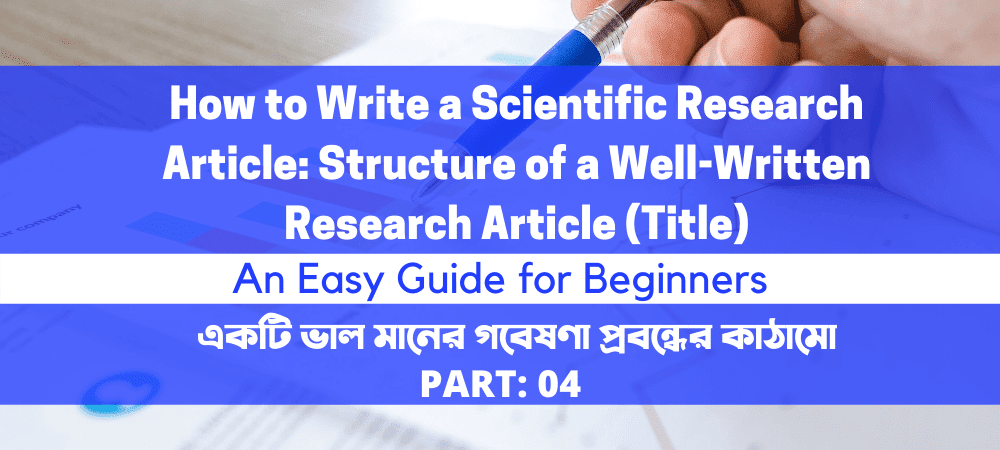[This article is bilingual in Bengali and English. Please scroll down this page to read it in English.]
কীভাবে একটি বৈজ্ঞানিক গবেষণা প্রবন্ধ লিখতে হয়
(পর্ব ৪)
একটি ভালো মানের গবেষণা প্রবন্ধের কাঠামো
চলুন গবেষণা প্রবন্ধের সবথেকে গুরুত্বপূর্ণ অংশ “শিরোনাম” দিয়ে শুরু করা যাক।
১. শিরোনাম
শিরোনাম বা টাইটেল কী?
শিরোনাম হচ্ছে আপনার গবেষণাপত্রের সব থেকে গুরুত্বপূর্ণ বিষয়। আপনি আপনার গবেষণাপত্রের শিরোনামকে একটি বিজ্ঞাপনের শিরোনামের সাথে তুলনা করতে পারেন। যেভাবে একটি বিজ্ঞাপনের শিরোনাম ওই বিজ্ঞাপনকে উপস্থাপন ও ব্যাখ্যা করে একইভাবে আপনার গবেষণাপত্রের শিরোনাম আপনার গবেষণার বিষয়বস্তুকে কিছু শব্দের মাধ্যমে উপস্থাপন ও ব্যাখ্যা করবে। তদুপরি, আপনার গবেষণা প্রবন্ধের জন্য এমন একটি শিরোনাম নির্বাচন করা আপনার দায়িত্ব যা কিনা পাঠকদের দৃষ্টি আকর্ষণ করতে এবং গবেষণা প্রবন্ধটি পড়ার জন্য আগ্রহ সৃষ্টি করতে সক্ষম।
একটি সৃজনশীল শিরোনাম তৈরি করা বেশ ক্লান্তিকর এবং কঠিন একটি কাজ। আমরা এই কঠিন কাজটি কে সহজ করার জন্য, কিভাবে গবেষণা প্রবন্ধের জন্য একটি যথাযথ শিরোনাম বাছাই করতে হয্ তা নিয়ে আলোচনা করব।
শিরোনাম বেছে নেওয়ার আগে যে বিষয়গুলো বিবেচনা করতে হবে
আপনার গবেষণা প্রবন্ধের জন্য একটি যথাযথ শিরোনাম বাছাই করার পূর্বে কিছু বিষয় রয়েছে যা বিবেচনা করতে হয়। এগুলো হলোঃ
- আপনার গবেষণার শিরোনামে যেন এই বিষয়গুলো থাকে তা নিশ্চিত করুনঃ (ক) বিষয়, (খ) কৌশল, (গ) মূল পদ্ধতি এবং (ঘ) ফলাফল।
- অপ্রয়োজনীয় শব্দ যথাসম্ভব কম রাখুন। শিরোনাম যথাসম্ভব সংক্ষিপ্ত রাখুন। আপনার এমন একটি শিরোনাম প্রয়োজন যা কিনা যারা আপনার গবেষণার বিষয়ে বিশেষজ্ঞ নয় তারাও যেন বুঝতে পারে।
- গবেষণার শিরোনাম ৫ থেকে ১৫ শব্দের মধ্যে সীমাবদ্ধ রাখুন।
- আপনি যদি বিশ্ববিদ্যালয়ের প্রজেক্ট কিংবা প্রাতিষ্ঠানিক জার্নালের জন্য কোন শিরোনাম নির্বাচন করেন তাহলে এই বিষয়টি নিশ্চিত করুন যে শিরোনামটি যেন ওই মাধ্যমের নিয়ম এবং প্রয়োজনীয়তা পূরণ করে। উদাহরণস্বরূপ অনেক জার্নালে তারা শিরোনামের জন্য শব্দ সংখ্যা এবং জায়গা নির্ধারণ করে দেয়। উপরন্তু, অনেক প্রতিষ্ঠান শিরোনামের জন্য নির্দিষ্ট বিন্যাস ঠিক করে দেয়, যা অনেক সময় শিরোনামের মৌলিকত্ব কে সীমাবদ্ধ করে।
- আপনার গবেষণার লক্ষ্যকে শিরোনামে ফুটিয়ে তুলতে বর্ণনামূলক শব্দ ব্যবহার করুন।
- সবথেকে গুরুত্বপূর্ণ বিষয়টি হচ্ছে, আপনার প্রবন্ধটি যেন সহজেই খুজে পাওয়া যায় এর জন্য শিরোনামে সমালোচনাযোগ্য এবং সহজ ও সাধারণ কিওয়ার্ড ব্যবহার করুন।
শিরোনামে যা থাকা উচিত নয়ঃ
- পিরিয়ড ব্যবহার না করা (এমনকি ঘোষণামূলক বাক্যাংশেও) এবং অপ্রয়োজনীয় হাইফেন ব্যবহার না করা (দুটি শব্দ সংযুক্ত করা ব্যতীত)।
- রাসায়নিক সূত্র, রোমান সংখ্যা এবং সেমিকোলন এড়িয়ে চলুন (তবে আপনি দুই অংশে বিভক্ত এমন শিরোনামে কোলন ব্যবহার করতে পারেন)।
- শব্দ সংক্ষেপ, সূচনা, এবং সারসংক্ষেপ এড়িয়ে চলুন।
- অপ্রচলিত শব্দ, অস্পষ্ট পদ এবং সংখ্যাবাচক সূচকের ব্যবহার এড়িয়ে চলুন।
- ইটালিক ফন্টে শিরোনাম লেখা এগিয়ে চলুন (শুধুমাত্র বৈজ্ঞানিক নামের ক্ষেত্রে লেখা যাবে)।
- শিরোনাম সংক্ষিপ্ত রাখার চেষ্টা করুন কেননা সংক্ষিপ্ত শিরোনাম সবথেকে বেশি পড়া হয়। শিরোনাম ৫০ থেকে ১০০ ক্যারেক্টারের মধ্যে সীমাবদ্ধ রাখুন যা সাধারণত ১২ থেকে ১৩টি শব্দ হবে।
- এমন শব্দ বা শব্দগুচ্ছের মাধ্যমে শুরু করা থেকে বিরত থাকুনঃ উদাহরণস্বরূপ, “Report on”, “A Study of”, “Results of”, “An Experimental Investigation of”, ইত্যাদি। (এগুলো কোন সুনির্দিষ্ট অর্থ প্রকাশ করে না)
পরবর্তী পর্বে আলোচনা করা হবেঃ কিভাবে একটি প্রাসঙ্গিক গবেষণার বিষয় নির্বাচন করবেন।
English Version:
Structure of a well-written research article
So, let’s start with the most crucial part of a research article, the “title”.
-
Title
What is Title?
The title of your research paper is the most critical section. You can consider it as the heading of an advertisement. Just as the header describes the ad, similarly, your title should aptly describe your research work in a few words. Moreover, it’s your job to select an excellent title for your article as it would draw in the reader’s attention and invoke a reading interest in him/her.
Formulating a creative title is a tedious job. To make this difficult task easy, we will next mention the points you should consider before choosing a title for your research article.
Points to consider before choosing a title
There are certain things to consider before choosing an appropriate title for your research article. They are:
- Ensure that the title of your research includes the following: (a) the topic, (b) the technique, (c) the key method, and (d) the findings.
- Keep needless words and jargon to a minimum. Make the title statement as brief as possible. You want a title that is understandable even to those who are not specialists in your subject.
- Ensure that your title is between 5 and 15 words long.
- If you’re composing a title for a university project or an academic journal, make sure it meets the norms and requirements for that medium. Many journals, for example, restrict titles to be under a certain number of characters, including spaces. In addition, many institutions need titles to adopt a set format, which limits your originality.
- Use a descriptive term to communicate the goal of your research effectively.
- Most importantly, employ critical keywords in the title to boost your article’s discoverability.
Your title shouldn’t have the following:
- No use of periods (even in declarative phrases) and unnecessary hyphens (except for linking two words).
- Avoid chemical formulas, roman numerals and even the semicolon (However, you can use the colon to create two-part titles).
- Abbreviations, initializations, and acronyms should be avoided.
- Avoid the use of uncommon words, vague terms and numerical exponents.
- Avoid writing the title in italics (unless you are mentioning scientific names).
- Try to keep your title short as shortened ones are more cited. However, you should always aim for 50-100 characters, i.e., 12-13 words.
- Avoid starting with a conjunction that is non-specific: for example, “Report on”, “A Study of”, “Results of”, “An Experimental Investigation of”, etc. (they do not contribute meaning!)
We will discuss in the next part: how to choose a relevant research topic.


